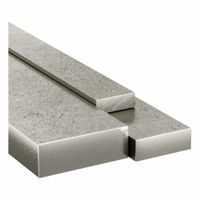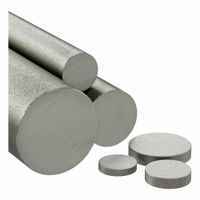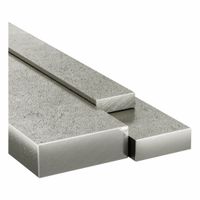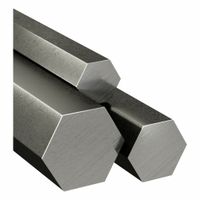Call +(254) 703 030 000 / 751 483 999 / 721 704 777
- Home
- Raw Materials
- Metals
- Carbon Steel
- Carbon Steel Bars Rods Discs
.....Read More
Frequently Asked Questions
What are the differences between hot rolled and cold rolled carbon steel bars?
Hot rolled carbon steel bars are produced by heating steel above its recrystallization temperature and then rolling it into shape. This process results in a rough surface finish and looser tolerances. The steel is more malleable, making it easier to work with for large structural components. It is typically less expensive due to the simpler manufacturing process. However, the cooling process can lead to slight warping, making it less precise.
Cold rolled carbon steel bars, on the other hand, are processed at room temperature after being hot rolled. This additional processing results in a smoother surface finish and tighter dimensional tolerances. Cold rolling increases the steel's strength and hardness through strain hardening. It is more expensive due to the extra processing steps but offers better surface quality and precision, making it suitable for applications requiring high accuracy and a polished appearance.
In summary, hot rolled steel is ideal for projects where precision and surface finish are not critical, while cold rolled steel is preferred for applications requiring tighter tolerances and a superior finish.
How do you choose the right carbon steel grade for a specific application?
To choose the right carbon steel grade for a specific application, consider the following factors:
1. **Mechanical Properties**: Determine the required strength, ductility, and hardness. Low carbon steels (e.g., AISI 1010) offer good ductility and are easy to form, while high carbon steels (e.g., AISI 1095) provide higher strength and hardness.
2. **Weldability**: Low carbon steels are generally more weldable. If welding is a key process, opt for grades with lower carbon content to minimize the risk of cracking.
3. **Machinability**: Consider the ease of machining. Medium carbon steels (e.g., AISI 1045) offer a balance between machinability and strength, suitable for parts requiring moderate strength and good machinability.
4. **Corrosion Resistance**: Carbon steels are not inherently corrosion-resistant. For applications exposed to moisture or corrosive environments, consider coatings or alternative materials unless the application allows for regular maintenance.
5. **Heat Treatment**: Determine if the application requires heat treatment for enhanced properties. High carbon steels can be heat-treated for increased hardness and strength.
6. **Cost**: Balance performance requirements with budget constraints. Low carbon steels are generally more cost-effective, while high carbon steels may incur additional costs due to heat treatment and machining.
7. **Application Environment**: Consider the operating environment, including temperature and exposure to chemicals. High carbon steels may become brittle at low temperatures, while low carbon steels may not perform well at high temperatures.
8. **Standards and Specifications**: Adhere to industry standards and specifications (e.g., ASTM, SAE) relevant to the application to ensure compliance and performance.
By evaluating these factors, you can select a carbon steel grade that meets the specific requirements of your application, ensuring optimal performance and cost-effectiveness.
What are the common uses of carbon steel rods and discs in industrial applications?
Carbon steel rods and discs are widely used in various industrial applications due to their strength, durability, and cost-effectiveness.
1. **Construction and Infrastructure**: Carbon steel rods are commonly used as reinforcement bars (rebar) in concrete structures, providing tensile strength to buildings, bridges, and roads. Discs are used in structural components and as base plates for columns and beams.
2. **Manufacturing and Fabrication**: In manufacturing, carbon steel rods serve as raw material for machining and fabricating parts like bolts, screws, and fasteners. Discs are used in the production of gears, flanges, and other machine components.
3. **Automotive Industry**: Carbon steel rods are used in the production of axles, shafts, and suspension components due to their high strength and wear resistance. Discs are used in brake systems and as components in engines and transmissions.
4. **Oil and Gas Industry**: In this sector, carbon steel rods are used in drilling equipment, pipelines, and as structural supports for rigs. Discs are used in valves, pumps, and pressure vessels due to their ability to withstand high pressure and temperature.
5. **Agriculture**: Carbon steel rods are used in the manufacturing of agricultural machinery and equipment, such as plows and harrows. Discs are used in disc harrows and other soil preparation tools.
6. **Tool and Die Making**: Carbon steel rods are used to produce cutting tools, dies, and molds due to their hardness and ability to maintain a sharp edge. Discs are used in grinding and cutting applications.
7. **Railway Industry**: Carbon steel rods are used in the construction of railway tracks and as components in train engines and carriages. Discs are used in braking systems and as structural components.
These applications highlight the versatility and essential role of carbon steel rods and discs in various industrial sectors.
How does the carbon content affect the properties of carbon steel?
The carbon content in carbon steel significantly influences its mechanical properties, including hardness, ductility, tensile strength, and weldability. As the carbon content increases, the steel generally becomes harder and stronger due to the formation of iron carbide (Fe3C), which impedes dislocation movement within the crystal lattice. This results in increased tensile strength and hardness, making high-carbon steels suitable for applications requiring wear resistance, such as cutting tools and springs.
However, higher carbon content also reduces ductility and toughness, making the steel more brittle and less able to absorb energy before fracturing. This brittleness can lead to cracking under stress or impact, limiting the use of high-carbon steels in applications where flexibility and toughness are critical.
Weldability is also affected by carbon content. Low-carbon steels (up to 0.3% carbon) are more easily welded because they are less prone to forming hard and brittle microstructures in the heat-affected zone. In contrast, high-carbon steels (above 0.6% carbon) require preheating and post-weld heat treatment to prevent cracking.
Additionally, carbon content influences the steel's response to heat treatment. Medium-carbon steels (0.3% to 0.6% carbon) can be heat-treated to achieve a balance of strength and ductility, making them suitable for automotive and structural applications.
In summary, increasing carbon content enhances hardness and strength but reduces ductility, toughness, and weldability. The choice of carbon content in steel depends on the desired balance of these properties for specific applications.
What are the advantages of using carbon steel hex bars for precision parts?
Carbon steel hex bars offer several advantages for precision parts:
1. **Strength and Durability**: Carbon steel is known for its high tensile strength and durability, making it ideal for parts that require robustness and longevity.
2. **Machinability**: Carbon steel hex bars are relatively easy to machine, allowing for precise shaping and detailing, which is crucial for precision parts.
3. **Cost-Effectiveness**: Compared to other materials like stainless steel or alloys, carbon steel is more affordable, reducing overall production costs without compromising quality.
4. **Versatility**: Available in various grades, carbon steel can be tailored to meet specific mechanical properties, making it suitable for a wide range of applications.
5. **Corrosion Resistance**: While not as corrosion-resistant as stainless steel, carbon steel can be treated with coatings or finishes to enhance its resistance, extending the life of the parts.
6. **Thermal Conductivity**: Carbon steel has good thermal conductivity, which is beneficial in applications where heat dissipation is important.
7. **Weldability**: Carbon steel hex bars can be easily welded, allowing for seamless integration into larger assemblies or complex structures.
8. **Dimensional Stability**: The hexagonal shape provides stability and ease of handling during manufacturing, ensuring consistent dimensions and reducing the risk of deformation.
9. **Availability**: Carbon steel hex bars are widely available, ensuring a steady supply for manufacturing needs and reducing lead times.
10. **Recyclability**: Carbon steel is recyclable, making it an environmentally friendly choice for manufacturers focused on sustainability.
These advantages make carbon steel hex bars a preferred choice for precision parts in industries such as automotive, construction, and machinery.
How do you prevent corrosion in carbon steel bars and rods?
To prevent corrosion in carbon steel bars and rods, several strategies can be employed:
1. **Coatings and Paints**: Applying protective coatings such as epoxy, polyurethane, or zinc-rich paints can create a barrier against moisture and corrosive elements.
2. **Galvanization**: This involves coating the steel with a layer of zinc, which acts as a sacrificial anode, corroding in place of the steel.
3. **Cathodic Protection**: This technique uses sacrificial anodes or impressed current systems to protect steel by making it the cathode of an electrochemical cell.
4. **Corrosion Inhibitors**: Adding chemical compounds that slow down the corrosion process can be effective, especially in closed systems like pipelines.
5. **Alloying**: Incorporating elements such as chromium, nickel, or molybdenum into the steel can enhance its corrosion resistance.
6. **Environmental Control**: Reducing exposure to corrosive environments by controlling humidity, temperature, and exposure to chemicals can significantly reduce corrosion.
7. **Regular Maintenance and Inspection**: Routine checks and maintenance can help identify early signs of corrosion and allow for timely intervention.
8. **Design Considerations**: Designing structures to avoid water traps, ensure proper drainage, and allow for adequate ventilation can minimize corrosion risks.
9. **Use of Corrosion-Resistant Materials**: In some cases, using stainless steel or other inherently corrosion-resistant materials may be more cost-effective in the long run.
10. **Surface Treatments**: Techniques like anodizing or phosphating can enhance the surface properties of steel, making it more resistant to corrosion.
Implementing a combination of these methods, tailored to the specific environmental conditions and application, can effectively prevent corrosion in carbon steel bars and rods.
What are the standard sizes and dimensions available for carbon steel flat bars?
Carbon steel flat bars are available in a variety of standard sizes and dimensions, which can vary slightly depending on the manufacturer and regional standards. However, some common dimensions include:
1. **Thickness**: Typically ranges from 1/8 inch (3.175 mm) to 2 inches (50.8 mm). Thinner bars are often used for lighter applications, while thicker bars are used for structural and heavy-duty purposes.
2. **Width**: Common widths range from 1/2 inch (12.7 mm) to 12 inches (304.8 mm). The width is usually selected based on the specific requirements of the application, such as load-bearing capacity and surface area.
3. **Length**: Standard lengths are usually 20 feet (6.1 meters) or 40 feet (12.2 meters), but custom lengths can be ordered based on specific project needs.
4. **Tolerances**: The tolerances for flat bars can vary, but they generally conform to standards such as ASTM A36, AISI, or other regional specifications. These standards ensure consistency in dimensions and mechanical properties.
5. **Edge Type**: Flat bars can have either mill edges or sheared edges. Mill edges are produced during the rolling process, while sheared edges are cut to size after rolling.
6. **Finish**: The surface finish can vary from hot-rolled, which has a rougher surface, to cold-finished, which is smoother and more precise in dimension.
These dimensions and specifications allow carbon steel flat bars to be used in a wide range of applications, including construction, manufacturing, and fabrication. They are chosen based on factors such as strength, flexibility, and resistance to wear and corrosion.





